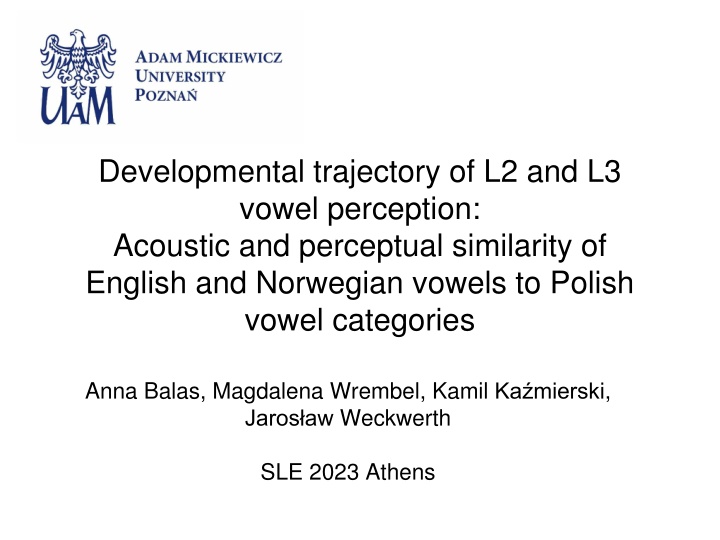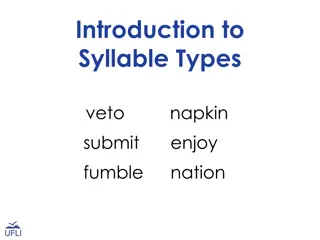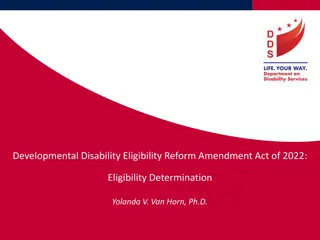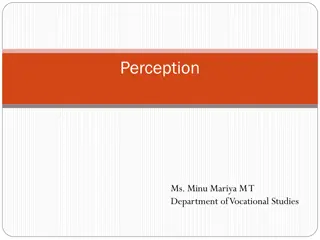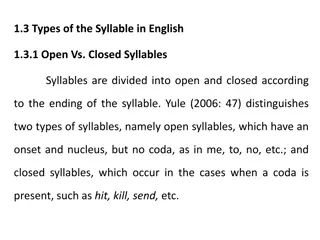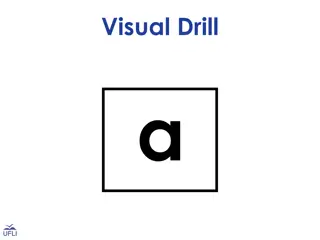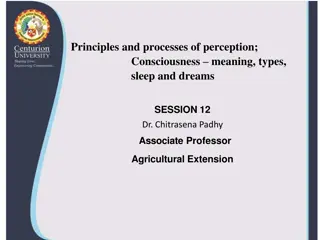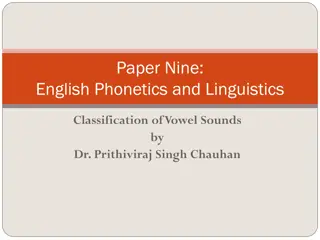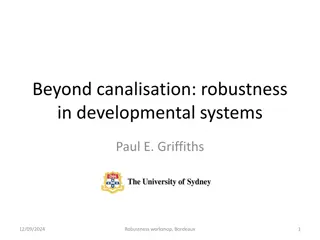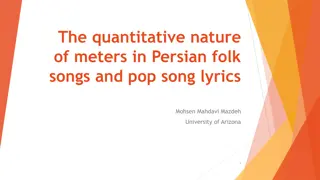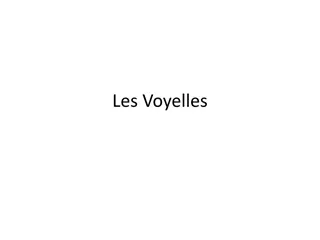Developmental Trajectory of L2 and L3 Vowel Perception
Acoustic and perceptual similarity of English and Norwegian vowels to Polish vowel categories in relation to non-native speech perception. Examining the role of language experience in distinguishing between L1 and L2 sounds, with insights from previous research on vowel identification and discrimination training. Discussing the perception of non-native lip rounding and the influence of experience on cross-linguistic vowel similarity.
Download Presentation

Please find below an Image/Link to download the presentation.
The content on the website is provided AS IS for your information and personal use only. It may not be sold, licensed, or shared on other websites without obtaining consent from the author.If you encounter any issues during the download, it is possible that the publisher has removed the file from their server.
You are allowed to download the files provided on this website for personal or commercial use, subject to the condition that they are used lawfully. All files are the property of their respective owners.
The content on the website is provided AS IS for your information and personal use only. It may not be sold, licensed, or shared on other websites without obtaining consent from the author.
E N D
Presentation Transcript
Developmental trajectory of L2 and L3 vowel perception: Acoustic and perceptual similarity of English and Norwegian vowels to Polish vowel categories Anna Balas, Magdalena Wrembel, Kamil Ka mierski, Jaros aw Weckwerth SLE 2023 Athens
The role of language experience in non- native speech perception Both PAM (Best 1995) and SLM (1995) state that adult listeners assimilate non-native sounds to native categories. The SLM (Flege 1995, Flege and Bohn 2021): in order to establish a new category for an L2 sound, learners need to detect differences between L1 and L2 sounds. The more experienced the L2/L3 learners are, the more likely they should be to discern the differences between the L1 and L2 sounds. Longitudinal experiments are challenging.
Previous research on the role of experience in non-native speech perception Usually experienced vs. inexperienced listeners, some heightened awareness of phonetic differences between L1 and L2 revealed: Flege 1991, Flege, Bohn and Jang 1997. Little support for the effect of experience in L2 vowel identification or categorization: Cerbian (2002), Cerbian (2006) found some effect on L1 vowel identification, but no effect on L2 vowel categorization (but the two groups actually differed in the character of exposure: immersion vs. formal setting). In a challenging oddity discrimination task: Rallo Fabra and Romero (2012)
Previous research on the role of experience in non-native speech perception Better effects of vowel identification than discrimination training in Carlet and Cebrian (2019). L2 identification and discrimination improved while perception of cross- linguistic similarity remained unchanged (Cebrian, Carlet, Gorba and Gavalda 2019), in line with a cross-sectional study by Flege, Munro and Fox (1994) Increased experience with the target language can influence the perceptual similarity between L1 and target language vowels (Flege 1991, Ingram and Park 1997) Iverson and Evans (2009): learners with a larger vowel inventory in L1 are initially at an advantage, learners with a smaller vowel inventory require more training to achieve similar results.
The perception of non-native lip rounding Strange, Bohn and Nishi (2004) examined acoustic and perceptual similarity of North German and American English vowels. They found that acoustic similarity did not always predict perceptual similarity, especially for front rounded vowels. Alispahic, Mulak and Escudero (2017) showed that detailed acoustic comparisons between native (Peruvian Spanish and Australian English) and non- native (Dutch) vowels predicted perception patterns more accurately than overall comparisons of inventory size. Although both Strange et al. (2004) and Alispahic et al. (2017) included front rounded vowels and observed peculiar assimilation patterns, they did not specifically investigate the role of lip rounding or F3 in the perceptuo-acoustic relationship. We are aiming at addressing this issue.
Vowel inventories Polish: /i a u/ English: /i e u / Norwegian: long vowels /i , y , , u , e , , o , / and short vowels /i, y, , u, e, , o, / (Kristoffersen 2000)
Euclidean distance Euclidean distance between vowels: the distance between two points in vowel space (Hz) It may be two-dimensional or three-dimensional: F1-F2 or F1-F2-F3.
Research questions RQ1: Do assimilation patterns of L2/L3 vowels depend on the Euclidean distance between a given non-native vowel and a target category? RQ2: Do the relationships between assimilations of L2/L3 vowels to native categories and their Euclidean distances change over time? RQ3: Does the Euclidean distance predict assimilation better in L2 or L3? RQ4: If we take into account the Euclidean distance, are L2 or L3 vowels perceived as worse exemplars of L1 categories? RQ5: Does lip rounding influence assimilation patterns?
Methodology: Participants 15 participants (9 females, 6 males), out of original pool N=24 L1 Polish L2 English (advanced, mean of language learning duration: 12 yrs) L3 Norwegian (2 months of intensive instruction) Mean age: 20 Instructed setting Three testing times after the onset of L3 Norwegian learning: T1 -- two months, T2 -- five months and T3 -- nine months.
Procedure Perceptual assimilation task in PsychoPy (Peirce et al. 2019) 10 English and 16 Norwegian monophthongs assimilated to six Polish vowel categories Orthographic labels used for six Polish vowel categories /i, , e, a, , u/ The stimuli in /dVd/ nonce words Randomised, 3x each (e.g., d d, did) Tested in separate blocks, on separate days Goodness of fit ratings of each non-native vowel to the chosen L1 category, on a Likert scale: 1 (weak fit) -- 7 (good fit)
Polish vowel targets Norwegian stimulus /i/ <i> 100% (5.77) 33.33% (5) 70.83% (4.59) 16.67% (5.25) /a/ <a> /u/ <u> / / <y> / / <e> / / <o> NA /i / TID /i/ FIN /y / LYS /y/ SYND /e / STED /e/ BEST / / L P / / S NN / / DAG / / TAKK /o/ R D /o/ NOK /u / BOK /u/ ROM / / GUD / / SLUTT 37.50% (5.41) 23.61% (5) 62.50% (4.64) 26.39% (5.21) 1.39% (1) 8.33% (5.17) 88.89% (5.14) 93.06% (5.9) 19.44% (5.14) 36.11% (4.35) 1.39% (3) 4.17% (4.33) 8.33% (2.33) 1.39% (4) 2.78% (5) 1.39% (2) 1.39% 6.94% (5.6) 5.56% (5) 5.56% (3.75) 8.33% (5) 100% (5.53) 98.61% (5.69) 2.78% (4) 1.39% (2) 9.72% (3.57) 11.11% (3.25) 58.33% (4.45) 33.33% (4.29) 6.94% (3.2) 6.94% (3.2) 4.17% (5.33) 1.39% (4) 1.39% (5) 97.22% (5.25) 98.61% (5.58) 38.89% (5.43) 72.22% (5.08) 1.39% (5) 9.72% (5) 1.39% (7) 1.39% 61.11% (5.02) 27.78% (4.9) 75% (4.72) 63.89% (4.65) 2.78% (7) 1.39% (3) 18.06% (4.23) 23.61% (4.12) 1.39% (1) 1.39% (5) 1.39% (7)
Polish vowel targets English stimulus /i/ <i> /a/ <a> /u/ <u> / / <y> / / <e> / / <o> NA 100% (5.81) /i / FLEECE 37.5% (5.04) 34.72% (5.84) 27.78% (6.15) / / KIT /e/ 98.61% (6.03) 1.39% (5) DRESS / / 100% (5.75) TRAP 13.89% 5.3 75% (5.13) 11.11% (4.5) / / STRUT 97.22% 5.53 1.39% (6) / / 1.39 (4) PALM 97.22% (5.67) 1.39 (3) 1.39 (5) / / THOUGHT 100% (5.15) /u / GOOSE 1.39% (7) 4.17% (4.67) 43.06% (4.61) 51.39% (3.86) / / FOOT 15.28% (4.09) 15.28% (2.64) 54.17% (4.62) 4.17% (1.33) 6.94% (4.8) 4.17% (6) / / NURSE
Assimilation rate as a function of ED: L3 Norwegian Assimilation Rate (AR) as a function of Euclidean distance AR averaged over time points and participants BEST BOK DAG FIN a 100% u 80% 60% i 40% a u i 20% i a u a u i 0% GUD LOP LYS NOK 100% i u 80% Mean assimilation rate 60% 40% u a u a i a 20% u a i i 0% RAD ROM SLUTT SONN 100% u 80% u 60% a u 40% a i i u 20% i a a i 0% STED SYND TAKK TID i a 100% 80% 60% 40% i a u 1,000 a 500 i 20% u 1,000 u i a u 1,500 0% 1,500 2,000 500 1,500 2,000 500 1,000 1,500 2,000 500 1,000 2,000 Euclidean distance Smooths based on within participant within time point assimilation rates
Assimilation rate as a function of ED: L2 English Assimilation Rate (AR) as a function of Euclidean distance AR averaged over time points and participants DRESS FLEECE FOOT GOOSE i u 100% 80% u 60% 40% 20% a i i a u i a u a 0% KIT NURSE PALM STRUT Mean assimilation rate a 100% a 80% 60% i 40% i a u 20% u u a u i i 0% 500 1,000 1,500 2,000 2,500 500 1,000 1,500 2,000 2,500 THOUGHT TRAP a a 100% 80% 60% 40% 20% u i u i 0% 500 1,000 1,500 2,000 2,500 500 1,000 1,500 2,000 2,500 Euclidean distance Smooths based on within participant within time point assimilation rates
Euclidean distance & assimilation count A negative binomial model was used to capture whether the F1-F2 Euclidean distance is related to how often a given Norwegian vowel is assimilated to a given Polish vowel. ED is negative and significant (z = -6.751, Pr(>|z|) = 1.46e- 11***) Similar results for English and for all the three testing times. RQ 1: YES -> The larger the Euclidean distance, the fewer assimilations are predicted.
Effect of ED on assimilation over time: L3 Norwegian RQ 2A: NO -> Weak and insignificant differences between testing times.
Effect of ED on assimilation over time: L2 English RQ 2B: NO -> Weak and insignificant differences between testing times.
Euclidean distance as predictor of assimilation in L2 vs. L3 Stronger effect of the ED in L3 than in L2 coefficient in Norwegian ed_z = -1.7 > English ed_z= - 0.61 assimilations in the better-known L2 English have stabilized Due to more experience in L2 than L3, the learners discern the differences between the L1 and foreign sounds RQ 3: The Euclidean distance predicts assimilation better in L3 than L2.
Goodness of fit in L2 vs. L3 Mixed effects linear model of Liker rating as a function of ED, language (L2, L3) and their interaction; by-participant random intercept. Larger Euclidean distance means lower goodness of fit ratings in both languages. Significant effect of language; L2 > L3 L2 English vowels seem more similar to L1 Polish vowels than L3 Norwegian vowels RQ 4: L2 English vowels rated as better exemplars of L1 categories than L3 Norwegian vowels
Effectofliprounding The interaction ed:marked_rounding is positive and significant, but the effect of marked_rounding is not significant RQ 5: hard to interpret
Individual variation: developmental trajectories (1) Examples of vowels with relatively stable assimilations over time across participants
Individual variation: developmental trajectories (2) Examples of vowels with considerable variability in assimilations over time across participants L3 NORWEGIAN
Individual variation: developmental trajectories (3) Examples of vowels with considerable variability in assimilations over time across participants L2 ENGLISH
Discussion Perceptual targets in L3 phonology are largely modulated by Euclidean distance, but they are influenced by other phonetic features -> these factors/factor combinations need further investigation. The perceptuo-acoustic similarity patterns, based on PAT and ED, are not substantially restructured during the first year of L3 learning. ED influences perception more in L3 Norwegian than in L2 English. With regard to the comparison of goodness of fit ratings, in the present language combination, L3 Norwegian has more marked vowels than the L2 English. Languages with comparable vowel inventories/less marked vowels should be examined (e.g. L1 Polish, L2 English, L3 Spanish?). Some indication that marked lip rounding may influence assimilation patterns.
Discussion The perception of cross-linguistic similarity remained unchanged over time in line with Cebrian et al. (2019), Flege et al. (1994) The character of exposure may play a role (cf. Cebrian 2006) here: formal setting not immersion L1 Polish learners with a small vowel inventory may be at a disadvantage (cf. Iverson and Evans 2009) For front rounded vowels more peculiar assimilation patterns were observed (as in Strange et al. 2004 and Alispahic et al. 2017)
Conclusions We aimed to trace developmental trajectory on 2 levels: (1) L2 vs. L3; Macro level (across-language) > differences attested as a function of language experience, in the expected direction (L2 categories more established, L3 more reliance on ED) (2) T1-T2-T3 Micro level (within language, across-participants) > little/no visible restructuring over time, maybe a too short time window (7 months); - > individual trajectories of development for some vowels Longitudinal experiment proved challenging (high drop-out rate)
Further research Future research should also investigate the relationship between L2 and L3 vowel assimilation and production development (cf. Wrembel et al. 2022). More challenging oddity discrimination task, rather than perceptual assimilation task, could shed further light. Would pairs of vowels that are close to each other in terms of the Euclidean distance be more difficult to discriminate than vowels with larger Euclidean distance? Where would there be a cut-off point? How about the impact of other features? Free classification (Daidone et al. 2023), suitable for L1s with few vowels. Fit index as an additional measure in the statistical analysis, in addition to the assimilation count and goodness of fit. Calculating overlap between pairs of vowels.
Bibliography Alispahic, S., Mulak K.E., & Escudero P. 2017. Acoustic properties predict perception of unfamiliar Dutch vowels by adult Australian English and Peruvian Spanish listeners. Frontiers in Psychology 8 (52). Best C. & Tyler, M. (2007). Non-native and second language speech perception: Commonalities and complementarities. In M. Munro & O-S. Bohn (Eds.), Language experience in second language speech learning: In honor of James Emil Flege (pp. 13-34). Amsterdam: John Benjamins. Carlet, A. & Cebrian, J. (2019) Assessing the effect of perceptual training on L2 vowel identification, generalization and long-term effects. In Anne Mette Nyvad, Michaela Hejn , Anders H jen, Anna Bothe Jespersen & Mette Hjortsh j S rensen (eds.): A Sound Approach to Language Matters In Honor of Ocke-Schwen Bohn. Dept. of English, School of Communication & Culture, Aarhus University, pp. 91-119. Cebrian, J., Carlet, A., Gorba, C., Gavald , N. (2019). Perceptual training affects L2 perception but not cross-linguistic similarity. In Sasha Calhoun, Paola Escudero, Marija Tabain & Paul Warren (eds.), Proceedings of the 19th International Congress of Phonetic Sciences, Melbourne, Australia 2019 (pp. 929-933). Canberra, Australia: Australasian Speech Science and Technology Association Inc. 2019. ISBN 978-0-646-80069-1. Cebrian, J. (2002) Acquiring a new vowel contrast: The perception of English lax-tense vowels by native Catalan subjects. In A. James & J. Leather (Eds.), Proceedings of the New Sounds 2000 4th International Symposium on the Acquisition of Second Language Speech. Amsterdam: University of Amsterdam (pp. 48-57). Cebrian, J. (2006) Experience and the use of duration in the categorization of L2 vowels. Journal of Phonetics 34, 372-387. ISSN: 0095-4470. Flege, J.E. (1995) The Speech Learning Model: Theory, findings and problems. In W. Strange (Ed.), Speech perception and linguistic experience: Issues in cross-language researchPublisher: York Press Flege, J.E. & Bohn, O-S. (2021) The Speech Learning Model revised. In R. Wayland (Ed.) Second language speech learning: Theoretical and empirical progress. Cambrige: CUP. Ingram, J.C.L., Park, S.G. 1997. Cross-language vowel perception and production by Japanese and Korean learners of English. Journal of Phonetics 25, 343-370. Peirce, J. W., Gray, J. R., Simpson, S., MacAskill, M. R., H chenberger, R., Sogo, H., Kastman, E., Lindel v, J.2019. PsychoPy2: experiments in behavior made easy. Behavior Research Methods.10.3758/s13428-018-01193-y Tyler, M.D., Best C.T., Faber, A. & Levitt, A.G. (2014). Perceptual Assimilation and Discrimination of Non-Native Vowel Contrasts. Phonetica 71, 4-21.
Acknowledgements This research is supported by a grant of the Polish National Science Centre (NCN), OPUS-19-HS project (UMO- 2020/37/B/HS2/00617), CLIMAD Cross-linguistic influence in multilingualism across domains: Phonology and syntax Norway funds/NCN grant GRIEG-1 (UMO- 2019/34/H/HS2/ 00495) ADIM Across-domain investigations in multilingualism: ModelingL3 acquisition in diverse settings
